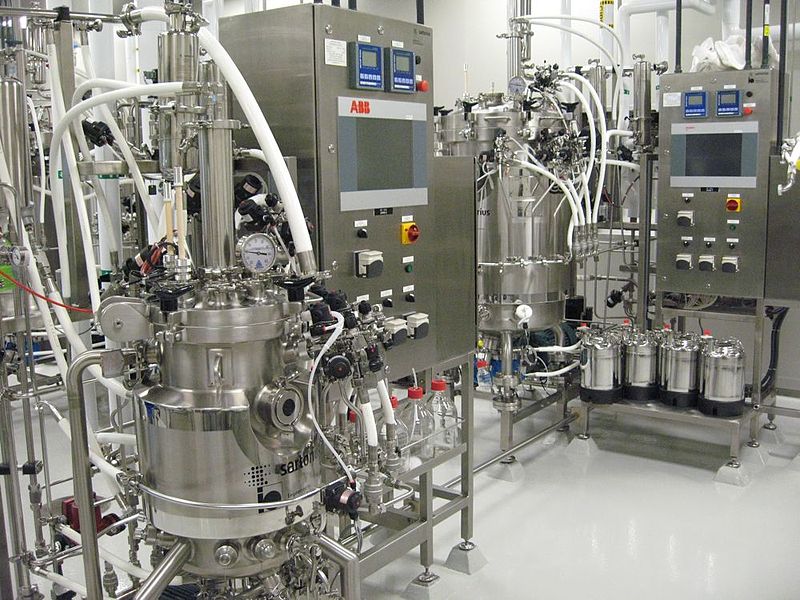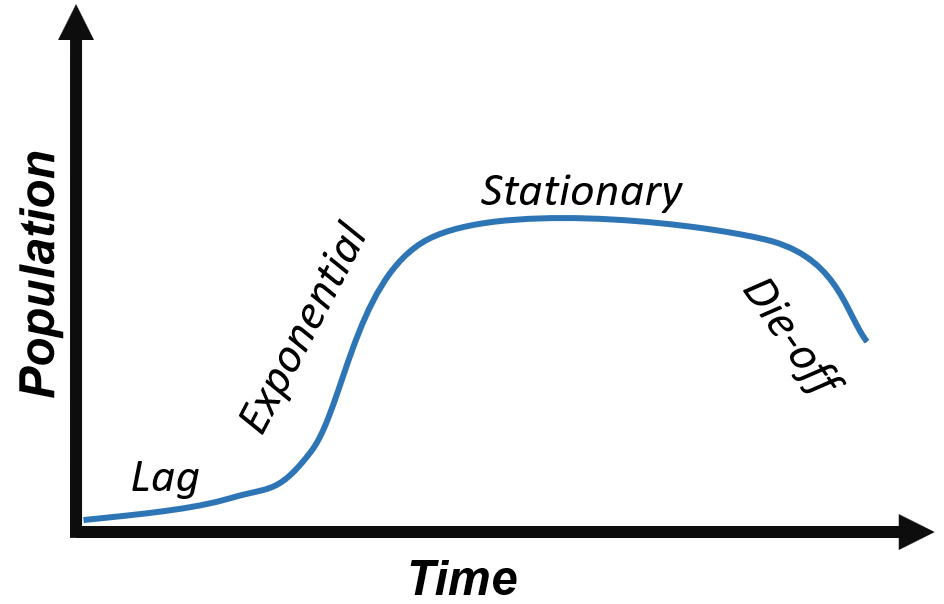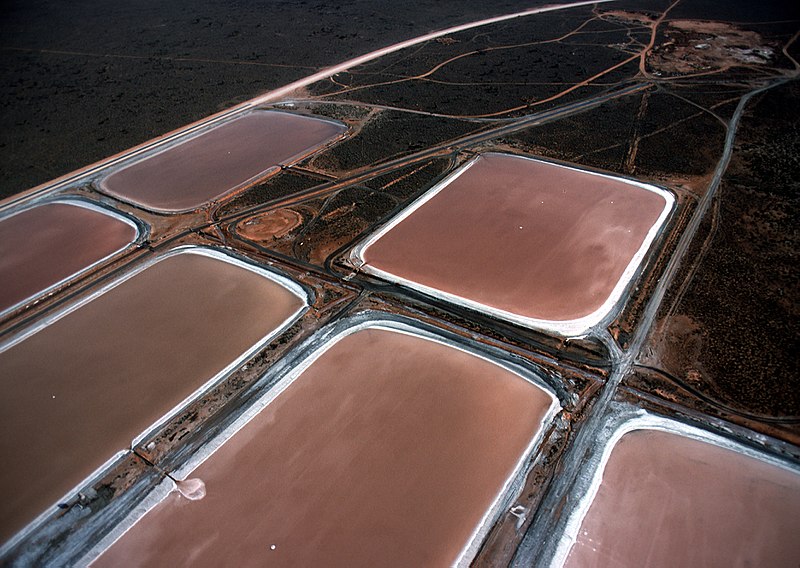It's only natural when you read about [rocket-fuel producing bacteria](https://steemit.com/steemstem/@effofex/bacterial-rocket-fuel-this-is-not-a-metaphor) that you might think, **let's grow some bugs and get our ass to Mars**! However, there's a ton of issues you've got tackle between finding hydrazine producing microbes and using them to produce the product at an industrial scale. These issues are illustrative of the general problems you might find in biotechnology and my goal is to use this an example to help you think critically about scaling up production whenever you find out about a bug that makes an interesting compound and are tempted to domesticate some microbes. <center></center> <center>It's a long way to this. [Source](https://en.wikipedia.org/wiki/File:BTEC_Bioreactors.jpg). Author: [Rick Lawless](https://en.wikipedia.org/wiki/User:RickLawless) under [CC3](https://creativecommons.org/licenses/by/3.0/).</center> As a quick review, here's what you need to know about our model system: Anammox bacteria can start from biologically available nitrogen and take it all the way to N<sub>2</sub>, this is unlike the 'usual' nitrogen cycle where different bugs cooperate to perform individual steps of the coversion. They do this by: 1. Combining ammonia and nitrous oxide to make hydrazine(N<sub>2</sub>H</sub>4), with the help of a **hydrazine hydrolase** enzyme 1. Breaking down hydrazine into dinitrogen using a **hydrazine oxidoreductase** enzyme 1. This all occurs within a specialized compartment called the **anammoxosome** # How much can we make: Growth rates and yields Assuming you know about a bug and the general conditions it grows in, the first two things you want to know are how fast does it grow (*growth rate*) and how much does it produce whatever you're interested in (*yield*). ## Growth Rates A classic way to think of bug growth rates splits it into the four phase shown in the figure below. <center></center> <center>General growth curve for bacteria. Author: Myself, under [CC0](https://creativecommons.org/share-your-work/public-domain/cc0/).</center> 1. **Lag:** Think of this as the 'moving in' period for the bugs. The bioreactor has just started and they're retooling their molecular machinery to get used to the environment. Little to no energy is spent in reproducing, so you see slow initial growth. 1. **Exponential:** The bugs have gotten used to their environment, there's plenty of excess food, and they're churning out copies of themselves *and their metabolites & enzymes* as quickly as possible. 1. **Stationary:** Things are still pretty happy for the bugs, but their population is fairly matched with the amount of food available. They aren't reproducing as quickly, some bugs are kind of old and tired, and they probably aren't making compounds as quickly as possible either. 1. **Die-off:** Many bugs are old and dying, further, they're probably swimming around in their own waste products, which are no good for them. (As an excercise, try to think where our own species is on this curve) Generally, we want to keep our bioreactors running the exponential phase, and there's suitable ways to do this, either by controlling flows in [continuous reactors](https://en.wikipedia.org/wiki/Chemostat) or playing with cycle times in [batch reactors](https://en.wikipedia.org/wiki/Batch_reactor). In the exponential phase, we can compare growth rates by talking about the *doubling time*, which is exactly what you think - the time it takes for a population of bugs to double in size. Here we come to our first issue: **anammox bacteria are slow growers** with a doubling time on the order of [one to two *weeks*](https://microbewiki.kenyon.edu/index.php/Anammox). Compare this with two bioreactor superstars, *E. coli* with a doubling time as short as [20 *minutes*](http://textbookofbacteriology.net/growth_3.html) and brewer's yeast at about an [hour or two](http://bionumbers.hms.harvard.edu/bionumber.aspx?id=108255). This slow growth rate means it takes time to get a lot of bugs and that it'll take forever to regrow things if(**when**) anything goes wrong in your reactor. ## Yield Yields are related to, but different from growth rates. The yield is the *amount of product produced per amount of biomass grown*. So, intuitively, the more biomass you can grow per unit time, the more product you can make. However, if changing conditions gives you a higher yield even at the cost of reduced growth, that may be the right way to go. Often, yields can be incredibly low and you won't get a useful amount no matter how fast your biomass grows. Here comes another issue: **anammox bacteria produce only enough hydrazine to meet their needs and the hydrazine is USED UP in the process**. I don't know of any published yields, but it's probably super low. ## Optimizing the growth process It is possible to play with all sorts of bioreactor parameters to change growth rates and yields to get optimum production. However, beyond some rules of thumb, figuring out those parameters and their ranges are unique research projects specific to each species and product. It would be difficult to stress just how labor, time, and money intensive this step can be. Beyond that, *you're not even guaranteed to find a useful optimum*. So far as I know, **no one has determined optimum conditions for anammox hydrazine production**. # Biological role in the organism For any compound you want, one question you should ask is if the bug is producing it as a *waste* or as a *necessary material*. If the compound is a waste material, then removing it from the system will not harm the bug. In fact, removal may be a necessity as it will first inhibit production and then eventually kill off your bugs. This is why alcohol (the grandaddy of blue-collar bug bioproduction) is so easy to get from brewer's yeast and why beer and wine don't get anywhere near 100% alcohol. <center></center> <center>Beer is proof that some useful compounds can be made with microbes. [Source](http://maxpixel.freegreatpicture.com/Beer-Mug-Foam-The-Thirst-Beer-Binge-Drinks-1669298) under [CC0](https://creativecommons.org/share-your-work/public-domain/cc0/).</center> If it's a necessary material there's a few issues. First, by definition, removing it from the system will harm your bugs, limiting growth and yield. Second, if it's a *consumed* material, it will likely be low-yield. Excepting some storage compounds (fats, starches), there's very little reason for organisms to produce more of something they need. In fact, every bit of overproduction costs them energy, and that means they are less fit for their environment. This is why we see things like [obligate parasites trimming down their genome](https://www.ncbi.nlm.nih.gov/pmc/articles/PMC3840695/) to to avoid producing stuff they can get for free from their host. If it's not consumed, then it is possible to get a good yield, particularly if you do some sort of batch harvest to get get around growth rate issues. This is why we're able to get useful lipids, pigments, and pharmaceuticals (like beta-carotene) [out of algae farms](https://www.ncbi.nlm.nih.gov/pmc/articles/PMC3124977/). <center></center> <center>Growing algae for fun and profit. [Source](http://www.scienceimage.csiro.au/library/landscapes/i/165/aerial-view-of-algae-farm-/) by Robert Kerton, under [CC3](https://creativecommons.org/licenses/by/3.0/deed.en).</center> Unfortunately for any would-be rocket explorers, **hydrazine is essential to anammox bacteria and is consumed as part of their metabolism**. # So, what's next? In my previous article I mentioned that listing *why* it's difficult to make hydrazine from bugs for a personal rocket fleet would be an article in itself. As it turns out, it's taken 1300+ words to get through just why growing them is a problem. In part II, I'll assume that we've somehow found a way to grow a reasonable batch of bugs and dig into issues with extraction, purification, and genetic hijinks.
| author | effofex |
|---|---|
| permlink | you-re-not-going-to-grow-bugs-to-power-your-rocket-part-1-of-2 |
| category | steemstem |
| json_metadata | {"tags":["steemstem","science","technology","microbiology","biotechnology"],"image":["https://steemitimages.com/DQmPzcSQ4jU3ZRDVhtoDud2UfabBqaPVqWxTqznuLwCUmGr/800px-BTEC_Bioreactors.jpg","https://steemitimages.com/DQmanaYV71rBZ86mBHpekwe5XyxMsq9SABjRemXwNPeAtmR/growth%20curve.png","https://steemitimages.com/DQmbzAVUDNEgBRTX4rECf87gXGG7nQGr7WAaTx4iYiPDbot/maxpixel.freegreatpicture.com-Beer-Mug-Foam-The-Thirst-Beer-Binge-Drinks-1669298.png","https://steemitimages.com/DQmVr4dYo3czETh6upepv5aFsxSxsFCDEEhR417nqsHnp28/800px-Algaefarm.jpg"],"links":["https://steemit.com/steemstem/@effofex/bacterial-rocket-fuel-this-is-not-a-metaphor","https://en.wikipedia.org/wiki/File:BTEC_Bioreactors.jpg","https://en.wikipedia.org/wiki/User:RickLawless","https://creativecommons.org/licenses/by/3.0/","https://creativecommons.org/share-your-work/public-domain/cc0/","https://en.wikipedia.org/wiki/Chemostat","https://en.wikipedia.org/wiki/Batch_reactor","https://microbewiki.kenyon.edu/index.php/Anammox","http://textbookofbacteriology.net/growth_3.html","http://bionumbers.hms.harvard.edu/bionumber.aspx?id=108255","http://maxpixel.freegreatpicture.com/Beer-Mug-Foam-The-Thirst-Beer-Binge-Drinks-1669298","https://www.ncbi.nlm.nih.gov/pmc/articles/PMC3840695/","https://www.ncbi.nlm.nih.gov/pmc/articles/PMC3124977/","http://www.scienceimage.csiro.au/library/landscapes/i/165/aerial-view-of-algae-farm-/","https://creativecommons.org/licenses/by/3.0/deed.en"],"app":"steemit/0.1","format":"markdown"} |
| created | 2018-03-07 05:18:36 |
| last_update | 2018-03-07 05:18:36 |
| depth | 0 |
| children | 11 |
| last_payout | 2018-03-14 05:18:36 |
| cashout_time | 1969-12-31 23:59:59 |
| total_payout_value | 21.516 HBD |
| curator_payout_value | 6.800 HBD |
| pending_payout_value | 0.000 HBD |
| promoted | 0.000 HBD |
| body_length | 8,633 |
| author_reputation | 14,429,105,750,792 |
| root_title | "You're not going to grow bugs to power your rocket. Part 1 of 2." |
| beneficiaries | [] |
| max_accepted_payout | 1,000,000.000 HBD |
| percent_hbd | 10,000 |
| post_id | 42,787,459 |
| net_rshares | 7,166,649,700,723 |
| author_curate_reward | "" |
| voter | weight | wgt% | rshares | pct | time |
|---|---|---|---|---|---|
| pharesim | 0 | 84,504,366,308 | 0.06% | ||
| kushed | 0 | 11,658,789,230 | 7.19% | ||
| steem-id | 0 | 62,273,348,741 | 7.19% | ||
| mrs.agsexplorer | 0 | 40,122,085,858 | 10% | ||
| kevinwong | 0 | 342,725,892,704 | 7.5% | ||
| justtryme90 | 0 | 284,233,000,786 | 10% | ||
| anwenbaumeister | 0 | 129,330,449,740 | 7.19% | ||
| grandpere | 0 | 43,851,067,037 | 25% | ||
| liberosist | 0 | 327,321,437,272 | 7.19% | ||
| arconite | 0 | 2,317,851,847 | 3.75% | ||
| dirty.hera | 0 | 479,236,424 | 7.19% | ||
| timsaid | 0 | 20,741,061,051 | 5% | ||
| velourex | 0 | 7,144,678,514 | 7.19% | ||
| lemouth | 0 | 75,429,914,413 | 18.75% | ||
| rjbauer85 | 0 | 872,530,792 | 25% | ||
| anarchyhasnogods | 0 | 40,803,499,847 | 12.5% | ||
| lamouthe | 0 | 5,595,276,547 | 25% | ||
| aschatria | 0 | 117,898,809 | 2.15% | ||
| steemedia | 0 | 799,946,264 | 7.19% | ||
| meerkat | 0 | 175,315,119,462 | 7.19% | ||
| curie | 0 | 303,497,292,420 | 7.19% | ||
| cebymaster | 0 | 996,742,194 | 7.19% | ||
| hendrikdegrote | 0 | 3,612,189,710,511 | 7.9% | ||
| steemstem | 0 | 626,668,229,591 | 25% | ||
| cotidiana | 0 | 890,579,059 | 7.19% | ||
| teofilex11 | 0 | 4,362,611,329 | 7.19% | ||
| brobear1995 | 0 | 55,028,773 | 3.59% | ||
| foundation | 0 | 2,283,762,461 | 25% | ||
| teamhumble | 0 | 301,655,118 | 0.07% | ||
| the-devil | 0 | 3,743,978,097 | 25% | ||
| thevenusproject | 0 | 12,716,446,176 | 25% | ||
| dna-replication | 0 | 10,059,999,686 | 40% | ||
| lenin-mccarthy | 0 | 427,088,336 | 3.59% | ||
| dyancuex | 0 | 76,492,616 | 3.59% | ||
| pacokam8 | 0 | 242,723,381 | 1.43% | ||
| jamhuery | 0 | 4,496,829,414 | 25% | ||
| toninux | 0 | 52,423,428 | 3.59% | ||
| devi1714 | 0 | 149,506,591 | 3.59% | ||
| jacalf | 0 | 54,533,941 | 7.19% | ||
| mobbs | 0 | 44,137,943,383 | 21.25% | ||
| bp423 | 0 | 781,169,241 | 7.19% | ||
| oscarcc89 | 0 | 200,962,739 | 0.71% | ||
| kryzsec | 0 | 7,717,775,026 | 25% | ||
| markangeltrueman | 0 | 1,076,764,593 | 3.59% | ||
| fredrikaa | 0 | 41,763,096,231 | 12.5% | ||
| lrsm13 | 0 | 67,659,537 | 2.15% | ||
| tantawi | 0 | 64,281,835 | 7.19% | ||
| locikll | 0 | 2,737,475,987 | 14.38% | ||
| dber | 0 | 9,103,635,073 | 25% | ||
| aboutyourbiz | 0 | 1,474,245,434 | 7.19% | ||
| dreamien | 0 | 554,282,997 | 7.19% | ||
| kerriknox | 0 | 101,768,249,738 | 25% | ||
| alexander.alexis | 0 | 1,391,883,226 | 5% | ||
| howtostartablog | 0 | 247,623,907 | 0.35% | ||
| blessing97 | 0 | 758,659,682 | 25% | ||
| sensation | 0 | 206,859,943 | 100% | ||
| zacherybinx | 0 | 56,189,255 | 7.19% | ||
| slickhustler007 | 0 | 302,049,180 | 3.59% | ||
| rockeynayak | 0 | 147,595,976 | 25% | ||
| ertwro | 0 | 9,570,642,067 | 25% | ||
| luigienius | 0 | 92,920,426 | 3.59% | ||
| coloringiship | 0 | 150,729,894 | 0.35% | ||
| nitesh9 | 0 | 5,857,406,760 | 25% | ||
| mcw | 0 | 36,588,853,302 | 80% | ||
| treeplanter | 0 | 198,850,303,472 | 23.51% | ||
| vibvir | 0 | 99,331,592 | 7.19% | ||
| himal | 0 | 1,695,145,363 | 25% | ||
| abigail-dantes | 0 | 338,024,083,889 | 25% | ||
| leczy | 0 | 2,272,185,443 | 25% | ||
| ovij | 0 | 2,634,513,888 | 25% | ||
| helgapn | 0 | 103,370,920 | 3.59% | ||
| justdentist | 0 | 586,638,261 | 0.57% | ||
| aauthespian1 | 0 | 83,040,464 | 7.19% | ||
| karyah1001 | 0 | 77,637,853 | 7.19% | ||
| somethingburger | 0 | 1,672,546,845 | 25% | ||
| infinitelearning | 0 | 287,945,997 | 3.59% | ||
| cryptonator | 0 | 1,882,584,098 | 7.19% | ||
| rejzons | 0 | 52,150,792 | 0.71% | ||
| smafey | 0 | 82,539,557 | 3.59% | ||
| marialefleitas | 0 | 75,637,470 | 3.59% | ||
| hillaryaa | 0 | 80,589,782 | 7.19% | ||
| afrikablr | 0 | 67,647,313 | 3.59% | ||
| stbrians | 0 | 122,625,880 | 3.59% | ||
| zeeshan003 | 0 | 432,455,010 | 25% | ||
| markmorbidity | 0 | 122,179,186 | 3.59% | ||
| bobdos | 0 | 247,697,972 | 0.71% | ||
| carloserp-2000 | 0 | 3,424,532,323 | 25% | ||
| pangoli | 0 | 887,098,680 | 25% | ||
| rachelsmantra | 0 | 1,008,427,686 | 25% | ||
| christianschmidt | 0 | 682,258,239 | 7.19% | ||
| sammarkjames | 0 | 219,488,028 | 7.19% | ||
| gra | 0 | 8,814,142,151 | 25% | ||
| artepoetico | 0 | 78,986,820 | 3.59% | ||
| sci-guy | 0 | 61,627,872 | 25% | ||
| arnavlavan | 0 | 240,523,957 | 3.59% | ||
| vintherinvest | 0 | 15,315,035,662 | 47% | ||
| delph-in-holland | 0 | 84,375,182 | 3.59% | ||
| spectrums | 0 | 519,697,305 | 7.19% | ||
| xanderslee | 0 | 440,432,387 | 7.19% | ||
| kenadis | 0 | 6,352,875,021 | 25% | ||
| esaia.mystic | 0 | 362,875,525 | 7.19% | ||
| amavi | 0 | 3,821,314,644 | 5% | ||
| romanaround | 0 | 223,341,079 | 0.71% | ||
| robotics101 | 0 | 754,072,757 | 25% | ||
| jaeydallah | 0 | 101,290,876 | 7.19% | ||
| gentleshaid | 0 | 3,991,496,230 | 25% | ||
| steembasicincome | 0 | 12,001,727,187 | 3% | ||
| crescendoofpeace | 0 | 53,615,191 | 3.59% | ||
| tito36 | 0 | 66,793,158 | 7.19% | ||
| dethclad | 0 | 125,495,650 | 3.59% | ||
| sco | 0 | 18,498,538,486 | 100% | ||
| iwanderela | 0 | 1,169,388,977 | 1% | ||
| dysfunctional | 0 | 1,482,176,567 | 12.5% | ||
| speaklife | 0 | 83,204,460 | 7.19% | ||
| yourmercury | 0 | 61,323,865 | 7.19% | ||
| keephy | 0 | 6,007,636,692 | 100% | ||
| laritheghost | 0 | 88,039,667 | 3.59% | ||
| hadji | 0 | 1,106,316,901 | 25% | ||
| steemstem-bot | 0 | 2,329,322,830 | 15% | ||
| admiralsp | 0 | 167,603,051 | 7.19% | ||
| revilationer | 0 | 132,920,848 | 3.59% | ||
| fidelpoet | 0 | 290,175,689 | 7.19% | ||
| neneandy | 0 | 345,114,888 | 4.31% | ||
| strings | 0 | 56,687,426 | 3.59% | ||
| mashiliyanage | 0 | 55,035,427 | 3.59% | ||
| deutsch-boost | 0 | 319,581,984 | 20% | ||
| kimp0gi | 0 | 60,364,588 | 7.19% | ||
| alexdory | 0 | 2,290,429,415 | 100% | ||
| benleemusic | 0 | 1,288,726,749 | 0.35% | ||
| zipporah | 0 | 452,560,620 | 1.43% | ||
| wrpx | 0 | 52,988,468 | 3.59% | ||
| positiveninja | 0 | 151,659,982 | 3.59% | ||
| fr4mer | 0 | 70,645,217 | 12.5% | ||
| blerdrage | 0 | 144,550,332 | 3.59% | ||
| effofex | 0 | 509,962,175 | 100% | ||
| pricelessrita | 0 | 118,559,392 | 3.59% | ||
| de-stem | 0 | 4,923,036,414 | 12.5% | ||
| qurator-tier-0 | 0 | 8,726,788,344 | 4% | ||
| blockmountain | 0 | 116,474,398 | 2.15% | ||
| moneyroad | 0 | 156,252,083 | 7.19% | ||
| sildude | 0 | 487,219,931 | 100% |
Awesome article and I am glad to have found you here. Gained a follower! This came exactly during my lunch break :D huge space geek here.. I have no idea why anyone would want to use hydrazine. Two of the greatest users have already migrated away from it, SpaceX is not using it and there was a signed document in the US ( in the last years) to find alternatives and ditch it altogether as a rocket fuel. Only a handful of Russian and Chinese rockets use it currently. Hydrazine also starts oxidative processes on the walls of the rocket tanks, which means that after each launch the tanks need washing or refurbisment ( sandblasting and ablation). Goodbye straight-away reusability. Methane based rocket fuel doesn't require cooling, it doesn't leak in the atmosphere during storage, is less bulky and can be stored at a greater density. Plus you can make it on MARS as you can read in my upcoming articles from the series about MARS. There are studies about ISRU plants being deployed there, which would also filter CO2 from the atmosphere and release O2 back. That being said, I know that hydrazine is used in other industries on Earth and maybe it fares better there. I can't wait to see what output you will get from your study. And I see you got a SteemSTEM vote meanwhile :) Congrats!
| author | alexdory |
|---|---|
| permlink | re-effofex-you-re-not-going-to-grow-bugs-to-power-your-rocket-part-1-of-2-20180307t125533867z |
| category | steemstem |
| json_metadata | {"tags":["steemstem"],"app":"steemit/0.1"} |
| created | 2018-03-07 12:55:33 |
| last_update | 2018-03-07 12:55:33 |
| depth | 1 |
| children | 4 |
| last_payout | 2018-03-14 12:55:33 |
| cashout_time | 1969-12-31 23:59:59 |
| total_payout_value | 0.000 HBD |
| curator_payout_value | 0.000 HBD |
| pending_payout_value | 0.000 HBD |
| promoted | 0.000 HBD |
| body_length | 1,298 |
| author_reputation | 6,862,980,134,251 |
| root_title | "You're not going to grow bugs to power your rocket. Part 1 of 2." |
| beneficiaries | [] |
| max_accepted_payout | 1,000,000.000 HBD |
| percent_hbd | 10,000 |
| post_id | 42,865,921 |
| net_rshares | 976,573,414 |
| author_curate_reward | "" |
| voter | weight | wgt% | rshares | pct | time |
|---|---|---|---|---|---|
| effofex | 0 | 507,739,141 | 100% | ||
| sildude | 0 | 468,834,273 | 100% |
Oh, for sure. As far as rocketry goes, I'm a fan of other propellants. Let's not also forget that hydrazine is also hella toxic. I'm a microbio guy and it's just cool that they make hydrazine. I'm using it as a model system here to show how you might reason about a bug's utility to produce 'stuff'. As far as alternative uses for hydrazine, I get into that in the next article, but the two big things are: 1) if you really want to make hyrdrazine from bugs, one of the few viable reasons is as a way to productively remove nitrogen from wastewater and 2) its main use is as a foaming agent, but that's a terrible article headline. My professional experience is actually in methane production, and I'm a big ISRU geek, so I'm really looking forward to that article!
| author | effofex |
|---|---|
| permlink | re-alexdory-re-effofex-you-re-not-going-to-grow-bugs-to-power-your-rocket-part-1-of-2-20180307t142543999z |
| category | steemstem |
| json_metadata | {"tags":["steemstem"],"app":"steemit/0.1"} |
| created | 2018-03-07 14:25:42 |
| last_update | 2018-03-07 14:25:42 |
| depth | 2 |
| children | 3 |
| last_payout | 2018-03-14 14:25:42 |
| cashout_time | 1969-12-31 23:59:59 |
| total_payout_value | 0.000 HBD |
| curator_payout_value | 0.000 HBD |
| pending_payout_value | 0.000 HBD |
| promoted | 0.000 HBD |
| body_length | 769 |
| author_reputation | 14,429,105,750,792 |
| root_title | "You're not going to grow bugs to power your rocket. Part 1 of 2." |
| beneficiaries | [] |
| max_accepted_payout | 1,000,000.000 HBD |
| percent_hbd | 10,000 |
| post_id | 42,884,675 |
| net_rshares | 1,977,221,867 |
| author_curate_reward | "" |
| voter | weight | wgt% | rshares | pct | time |
|---|---|---|---|---|---|
| alexdory | 0 | 1,496,130,489 | 100% | ||
| sildude | 0 | 481,091,378 | 100% |
[This incident came to mind when I thought of hydrazine]( https://en.wikipedia.org/wiki/1980_Damascus_Titan_missile_explosion). An aerozyne (50% hydrazine) leak caused a 9 megaton warhead tipped ICBM missile to explode, luckily destroying only the silo. I remember reading about how toxic this chemical was in Eric Schlosser's terrific book Command and Control. I think most ICBMs use this stuff as fuel.
| author | sildude |
|---|---|
| permlink | re-effofex-re-alexdory-re-effofex-you-re-not-going-to-grow-bugs-to-power-your-rocket-part-1-of-2-20180308t140910991z |
| category | steemstem |
| json_metadata | {"tags":["steemstem"],"links":["https://en.wikipedia.org/wiki/1980_Damascus_Titan_missile_explosion"],"app":"steemit/0.1"} |
| created | 2018-03-08 14:09:00 |
| last_update | 2018-03-08 14:10:06 |
| depth | 3 |
| children | 2 |
| last_payout | 2018-03-15 14:09:00 |
| cashout_time | 1969-12-31 23:59:59 |
| total_payout_value | 0.000 HBD |
| curator_payout_value | 0.000 HBD |
| pending_payout_value | 0.000 HBD |
| promoted | 0.000 HBD |
| body_length | 404 |
| author_reputation | 276,875,462,200 |
| root_title | "You're not going to grow bugs to power your rocket. Part 1 of 2." |
| beneficiaries | [] |
| max_accepted_payout | 1,000,000.000 HBD |
| percent_hbd | 10,000 |
| post_id | 43,118,251 |
| net_rshares | 648,257,157 |
| author_curate_reward | "" |
| voter | weight | wgt% | rshares | pct | time |
|---|---|---|---|---|---|
| effofex | 0 | 648,257,157 | 100% |
Why isn't it possible to transfect E. coli or some other fast-growing bug with the necessary genes for hydrazine production, without giving them the genes for hydrazine comsumation?
| author | sco | ||||||
|---|---|---|---|---|---|---|---|
| permlink | re-effofex-201837t84541786z | ||||||
| category | steemstem | ||||||
| json_metadata | {"tags":["steemstem","science","technology","microbiology","biotechnology"],"app":"esteem/1.5.1","format":"markdown+html","community":"esteem"} | ||||||
| created | 2018-03-07 07:45:48 | ||||||
| last_update | 2018-03-07 07:45:48 | ||||||
| depth | 1 | ||||||
| children | 3 | ||||||
| last_payout | 2018-03-14 07:45:48 | ||||||
| cashout_time | 1969-12-31 23:59:59 | ||||||
| total_payout_value | 0.000 HBD | ||||||
| curator_payout_value | 0.000 HBD | ||||||
| pending_payout_value | 0.000 HBD | ||||||
| promoted | 0.000 HBD | ||||||
| body_length | 181 | ||||||
| author_reputation | 26,264,799,791,405 | ||||||
| root_title | "You're not going to grow bugs to power your rocket. Part 1 of 2." | ||||||
| beneficiaries |
| ||||||
| max_accepted_payout | 1,000,000.000 HBD | ||||||
| percent_hbd | 10,000 | ||||||
| post_id | 42,811,183 | ||||||
| net_rshares | 517,503,355 | ||||||
| author_curate_reward | "" |
| voter | weight | wgt% | rshares | pct | time |
|---|---|---|---|---|---|
| effofex | 0 | 517,503,355 | 100% |
I would keep the astronauts as far away from E.coli as I could :))) I am also interested in this mutation if it would be possible, although if you read my other comment you will see that there are many other problems with the use of hydrazine itself as a rocket fuel. But I am sure that if we could generate lots of it for free and while in space that would change instantly :D
| author | alexdory |
|---|---|
| permlink | re-sco-re-effofex-201837t84541786z-20180307t130035120z |
| category | steemstem |
| json_metadata | {"tags":["steemstem"],"app":"steemit/0.1"} |
| created | 2018-03-07 13:00:36 |
| last_update | 2018-03-07 13:00:36 |
| depth | 2 |
| children | 1 |
| last_payout | 2018-03-14 13:00:36 |
| cashout_time | 1969-12-31 23:59:59 |
| total_payout_value | 0.000 HBD |
| curator_payout_value | 0.000 HBD |
| pending_payout_value | 0.000 HBD |
| promoted | 0.000 HBD |
| body_length | 377 |
| author_reputation | 6,862,980,134,251 |
| root_title | "You're not going to grow bugs to power your rocket. Part 1 of 2." |
| beneficiaries | [] |
| max_accepted_payout | 1,000,000.000 HBD |
| percent_hbd | 10,000 |
| post_id | 42,866,989 |
| net_rshares | 488,210,712 |
| author_curate_reward | "" |
| voter | weight | wgt% | rshares | pct | time |
|---|---|---|---|---|---|
| effofex | 0 | 488,210,712 | 100% |
Eh, the astronauts are already chock-full o' *E. coli*. Just don't use a pathogenic strain. If you're really worried you could try to express it in a different vector, but that has issues in itself.
| author | effofex |
|---|---|
| permlink | re-alexdory-re-sco-re-effofex-201837t84541786z-20180307t143146998z |
| category | steemstem |
| json_metadata | {"tags":["steemstem"],"app":"steemit/0.1"} |
| created | 2018-03-07 14:31:45 |
| last_update | 2018-03-07 14:31:45 |
| depth | 3 |
| children | 0 |
| last_payout | 2018-03-14 14:31:45 |
| cashout_time | 1969-12-31 23:59:59 |
| total_payout_value | 0.000 HBD |
| curator_payout_value | 0.000 HBD |
| pending_payout_value | 0.000 HBD |
| promoted | 0.000 HBD |
| body_length | 198 |
| author_reputation | 14,429,105,750,792 |
| root_title | "You're not going to grow bugs to power your rocket. Part 1 of 2." |
| beneficiaries | [] |
| max_accepted_payout | 1,000,000.000 HBD |
| percent_hbd | 10,000 |
| post_id | 42,885,890 |
| net_rshares | 0 |
I'm glad you asked this, I go into that in part II!
| author | effofex |
|---|---|
| permlink | re-sco-re-effofex-201837t84541786z-20180307t141958535z |
| category | steemstem |
| json_metadata | {"tags":["steemstem"],"app":"steemit/0.1"} |
| created | 2018-03-07 14:20:00 |
| last_update | 2018-03-07 14:26:24 |
| depth | 2 |
| children | 0 |
| last_payout | 2018-03-14 14:20:00 |
| cashout_time | 1969-12-31 23:59:59 |
| total_payout_value | 0.000 HBD |
| curator_payout_value | 0.000 HBD |
| pending_payout_value | 0.000 HBD |
| promoted | 0.000 HBD |
| body_length | 51 |
| author_reputation | 14,429,105,750,792 |
| root_title | "You're not going to grow bugs to power your rocket. Part 1 of 2." |
| beneficiaries | [] |
| max_accepted_payout | 1,000,000.000 HBD |
| percent_hbd | 10,000 |
| post_id | 42,883,419 |
| net_rshares | 0 |
<center><a href="www.steemit.com/@steemstem"><img src="https://media.discordapp.net/attachments/384404201544876032/405507994583957505/steemSTEM.png"></a><br><table><tr><th> </th><th> </th><th><a href="https://steemit.com/steemstem/@steemstem/helpful-guidelines-for-crafting-steemstem-content">Guidelines</a></th><th><a href="https://steemit.com/steemstem/@steemstem/steemstem-winter-2017-2018-project-update">Project Update</a></th><th> </th><th> </th></tr></table><br><a href="https://steemit.com/steemstem/@steemstem/being-a-member-of-the-steemstem-community"><b>Being A SteemStem Member</b></a></center>
| author | steemstem-bot |
|---|---|
| permlink | re-you-re-not-going-to-grow-bugs-to-power-your-rocket-part-1-of-2-20180307t205130 |
| category | steemstem |
| json_metadata | "" |
| created | 2018-03-07 20:51:33 |
| last_update | 2018-03-07 20:51:33 |
| depth | 1 |
| children | 0 |
| last_payout | 2018-03-14 20:51:33 |
| cashout_time | 1969-12-31 23:59:59 |
| total_payout_value | 0.564 HBD |
| curator_payout_value | 0.000 HBD |
| pending_payout_value | 0.000 HBD |
| promoted | 0.000 HBD |
| body_length | 606 |
| author_reputation | 3,811,533,615,496 |
| root_title | "You're not going to grow bugs to power your rocket. Part 1 of 2." |
| beneficiaries | [] |
| max_accepted_payout | 1,000,000.000 HBD |
| percent_hbd | 10,000 |
| post_id | 42,956,329 |
| net_rshares | 142,624,239,534 |
| author_curate_reward | "" |
| voter | weight | wgt% | rshares | pct | time |
|---|---|---|---|---|---|
| justtryme90 | 0 | 142,116,500,393 | 5% | ||
| effofex | 0 | 507,739,141 | 100% |
<center><h3>You just planted 0.76 tree(s)!</h3> Thanks to @effofex <h3>We have planted already 5003.32 trees out of 1,000,000<h3> Let's save and restore Abongphen Highland Forest in Cameroonian village Kedjom-Keku! Plant trees with @treeplanter and get paid for it! My Steem Power = 20716.69 Thanks a lot! @martin.mikes coordinator of @kedjom-keku </center>
| author | treeplanter |
|---|---|
| permlink | re-effofex-you-re-not-going-to-grow-bugs-to-power-your-rocket-part-1-of-2-20180308t093841828z |
| category | steemstem |
| json_metadata | {} |
| created | 2018-03-08 09:38:42 |
| last_update | 2018-03-08 09:38:42 |
| depth | 1 |
| children | 0 |
| last_payout | 2018-03-15 09:38:42 |
| cashout_time | 1969-12-31 23:59:59 |
| total_payout_value | 0.000 HBD |
| curator_payout_value | 0.000 HBD |
| pending_payout_value | 0.000 HBD |
| promoted | 0.000 HBD |
| body_length | 489 |
| author_reputation | 62,929,728,687,402 |
| root_title | "You're not going to grow bugs to power your rocket. Part 1 of 2." |
| beneficiaries | [] |
| max_accepted_payout | 1,000,000.000 HBD |
| percent_hbd | 10,000 |
| post_id | 43,071,876 |
| net_rshares | 244,353,079 |
| author_curate_reward | "" |
| voter | weight | wgt% | rshares | pct | time |
|---|---|---|---|---|---|
| treeassistant | 0 | 244,353,079 | 100% |
 hiveblocks
hiveblocks